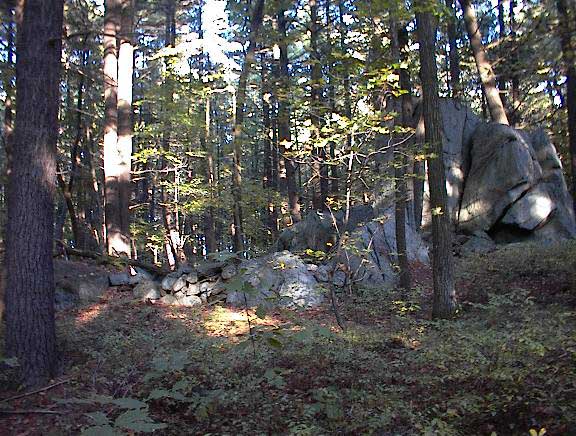
Here are some inter-related articles about rock piles in eastern Massachusetts, mostly northwest of Boston in Middlesex County. These are photo essays; the information is deliberately communicated visually and I did not want to feel limited in how many pictures I allowed myself. So there are lots of photos. Providing a visual record of these features is one goal but there is also a good deal of speculation attempting to frame a finer level of detail to the observations. I include photographs taken at some of the more than one hundred and forty different rock pile sites that have been located in this area.
At the beginning, in the first article or so, I take time to argue the case that most of the stone features I am studying are Native American. From my point of view that has become increasingly obvious and, rather than dwelling on the contoversy about these things, I am much more interested in the stone features themselves and in deciphering what they might mean and perhaps understanding a little about the people who made them. For that reason these articles are dedicated to people who wish to understand rock piles, especially my friends who go out walking with me.
Rock piles in Eastern Massacusetts are different from the ones reported from further north in Vermont and further south in Connecticut and even Pennsylvania. Our rock piles are mostly small, low to the ground, and often only contain a handful of rocks. This is very different from the huge monumental piles containing thousands of rocks which are reported from elsewhere. Also our rock piles are distinctly related to water because most sites are near water or look out over water. Perhaps these things are also present elsewhere but have not yet been reported. In any case, although humble, our rock piles are very interesting. They have a lot of structure and a lot of character and I believe they will reward our interest with deeper insights.
A persistent theme in these articles is the mystery of how quartz is
being used in different contexts. Virtually every type of stone feature
occasionally incorporates quartz, and sometimes it is in a way that
appears strategic and not random. So we should remember the general
principle that quartz is white and that white is the color associated
to wisdom and enlightenment. Perhaps that is a clue.
Split-Wedged Rocks
Rock on Rock
Twins
Rock Pile Site Distribution
Types of Rock Pile
The Indian Farmer
Three Rock Pile Sites
Review and Summary
Recently as a result both of more careful investigation and a growing interest in and understanding of archeo-astronomy (the subject of sky watching in the past), mounds and ceremonial structures have started to be understood as part of a complex Indian spiritual life. In that life, the sky - with sun, moon, and stars; the ground; the waters; the people; the animals and plants; and possibly also the land of the dead; are all inter-related by a spiritual energy that can be guided, channeled, and perhaps controlled using rocks and landforms.

These structures are as common in Massachusetts as anywhere else in America and until quite recently Indians continued to create them at special places around here. How could we not notice? We need to pay closer attention to what is in the woods in order to see it and understand it. Now that we ourselves are the stewards of these woods, while we pursue our own activities, we can try to learn something from the people who were here before us.